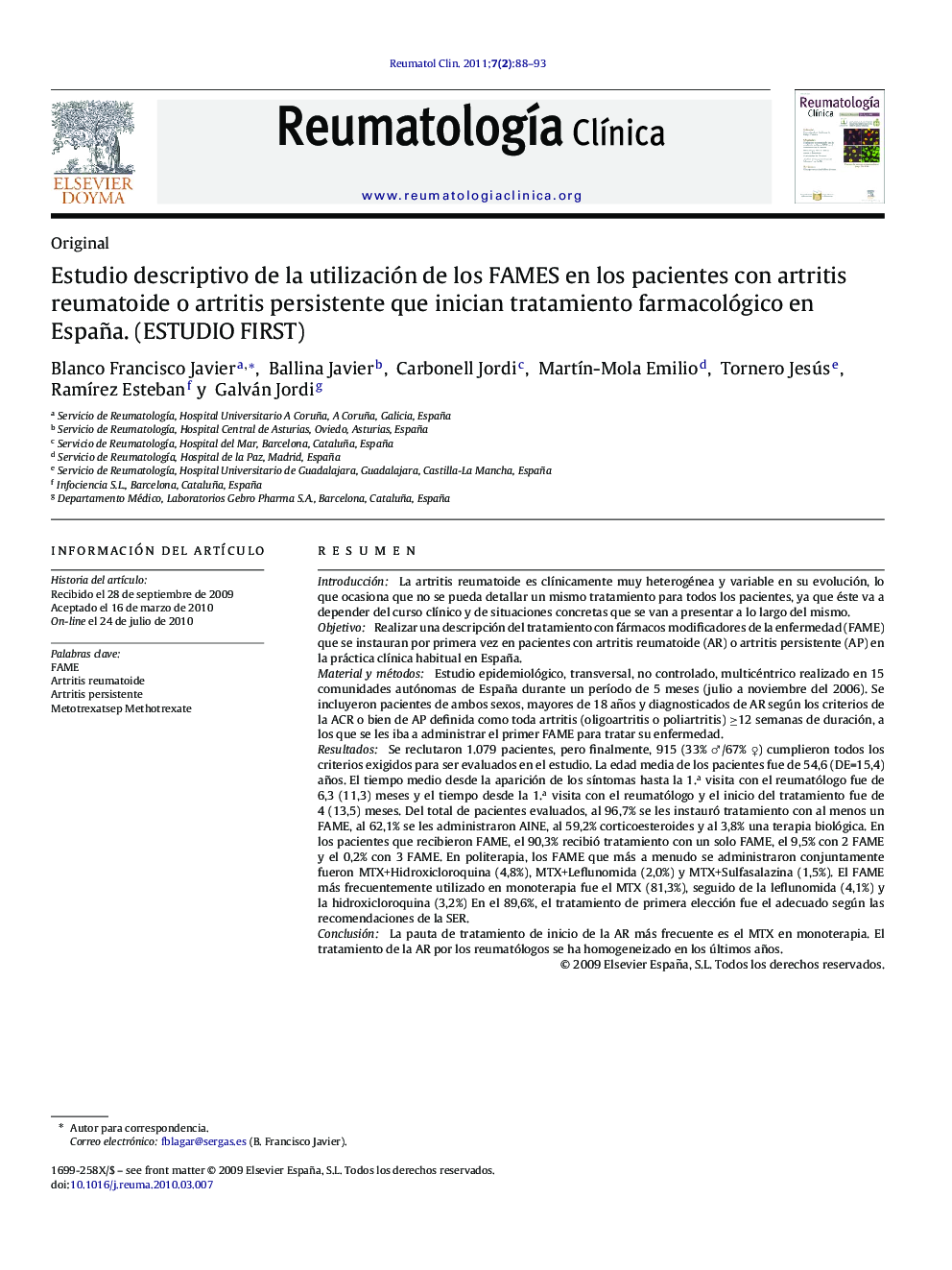| Article ID | Journal | Published Year | Pages | File Type |
|---|---|---|---|---|
| 3383434 | Reumatología Clínica | 2011 | 6 Pages |
ResumenIntroducciónLa artritis reumatoide es clínicamente muy heterogénea y variable en su evolución, lo que ocasiona que no se pueda detallar un mismo tratamiento para todos los pacientes, ya que éste va a depender del curso clínico y de situaciones concretas que se van a presentar a lo largo del mismo.ObjetivoRealizar una descripción del tratamiento con fármacos modificadores de la enfermedad (FAME) que se instauran por primera vez en pacientes con artritis reumatoide (AR) o artritis persistente (AP) en la práctica clínica habitual en España.Material y métodosEstudio epidemiológico, transversal, no controlado, multicéntrico realizado en 15 comunidades autónomas de España durante un período de 5 meses (julio a noviembre del 2006). Se incluyeron pacientes de ambos sexos, mayores de 18 años y diagnosticados de AR según los criterios de la ACR o bien de AP definida como toda artritis (oligoartritis o poliartritis) ≥12 semanas de duración, a los que se les iba a administrar el primer FAME para tratar su enfermedad.ResultadosSe reclutaron 1.079 pacientes, pero finalmente, 915 (33% ♂/67% ♀) cumplieron todos los criterios exigidos para ser evaluados en el estudio. La edad media de los pacientes fue de 54,6 (DE=15,4) años. El tiempo medio desde la aparición de los síntomas hasta la 1.a visita con el reumatólogo fue de 6,3 (11,3) meses y el tiempo desde la 1.a visita con el reumatólogo y el inicio del tratamiento fue de 4 (13,5) meses. Del total de pacientes evaluados, al 96,7% se les instauró tratamiento con al menos un FAME, al 62,1% se les administraron AINE, al 59,2% corticoesteroides y al 3,8% una terapia biológica. En los pacientes que recibieron FAME, el 90,3% recibió tratamiento con un solo FAME, el 9,5% con 2 FAME y el 0,2% con 3 FAME. En politerapia, los FAME que más a menudo se administraron conjuntamente fueron MTX+Hidroxicloroquina (4,8%), MTX+Leflunomida (2,0%) y MTX+Sulfasalazina (1,5%). El FAME más frecuentemente utilizado en monoterapia fue el MTX (81,3%), seguido de la leflunomida (4,1%) y la hidroxicloroquina (3,2%) En el 89,6%, el tratamiento de primera elección fue el adecuado según las recomendaciones de la SER.ConclusiónLa pauta de tratamiento de inicio de la AR más frecuente es el MTX en monoterapia. El tratamiento de la AR por los reumatólogos se ha homogeneizado en los últimos años.
IntroductionRheumatoid arthritis is clinically very heterogeneous and variable in its progression, and no one treatment works the same for all patients, as this will depend on the clinical course and specific situations.ObjectiveTo describe the treatment with DMARDs established for the first time in patients with rheumatoid arthritis (RA) or persistent arthritis (PA) in routine clinical practice in Spain.Material and methodsEpidemiological, cross-sectional, uncontrolled, multicenter study in 15 regions of Spain during a period of five months (July to November 2006). We included patients of both genders, aged 18 years and diagnosed with RA according to ACR criteria or PA defined as any arthritis (oligoarthritis or polyarthritis) lasting ≥12 weeks, which would be given DMARD to treat their disease.Results1079 patients were recruited, 915 analyzed (33% ♂/♀ 67%) meeting all the criteria required to be evaluated in the study. Mean age of patients was 54.6 (SD=15.4) years. The mean time from onset of symptoms until the 1st visit with the rheumatologist was 6.3 (11.3) months and the time from the 1st visit with the rheumatologist and the start of treatment was 4 (13.5) months. Of the patients tested, 96.7% was treated with at least one DMARD, 62.1% were given NSAIDs, corticosteroids to 59.2% and 3.8% biological therapy. In patients who received DMARDs, 90.3% received treatment with a single DMARD, 9.5% with 2 DMARDs and 0.2% with three DMARDs. In polytherapy, the DMARDs that are most often administered together were MTX + hydroxychloroquine (4.8%), MTX + leflunomide (2.0%) and MTX + sulfasalazine (1.5%). The most frequently used DMARD in monotherapy was MTX (81.3%), followed by leflunomide (4.1%) and hydroxychloroquine (3.2%). In 89.6%, the treatment of first choice was adequate according to the SER.ConclusionThe most common pattern of initial treatment of RA is MTX monotherapy. Treatment of RA by rheumatologists has been homogenized in recent years.
